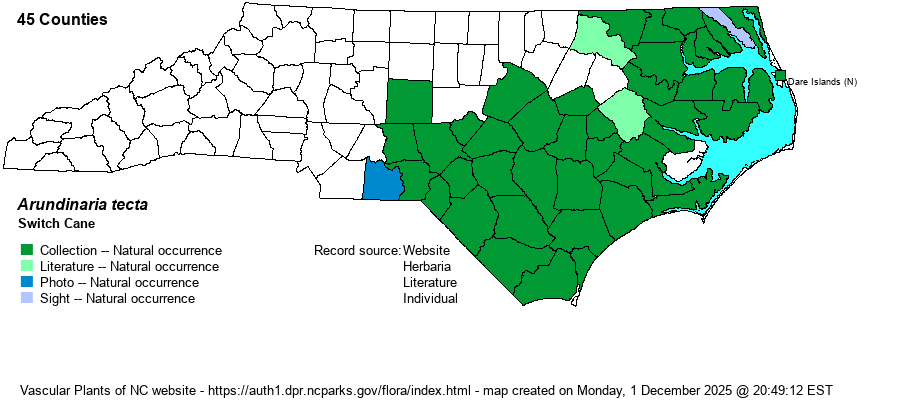| Author | (Walter) Muhlenberg | |
| Distribution | Strictly the Coastal Plain, including the northern Outer Banks. Reports and records from farther west are not supported by specimen evidence (except for valid records from Anson, Montgomery, and Randolph counties at streamheads in Coastal Plain-like habitat). They are either A. appalachiana or A. gigantea (sensu stricto). The specimen from Randolph County (herbarium NCU) was annotated to A. tecta, but the ID should be double-checked vs. A. appalachiana.
Coastal Plain, eastern MD south to northern FL and southeastern LA. | |
| Abundance | Common to often abundant in Coastal Plain and Sandhills; uncommon in lower Piedmont. It is one of the most numerous “shrub” species in the Coastal Plain, and when frequently burned forms dense thickets or canebrakes. Large canebrakes now are restricted to Fort Bragg and Sandhills Game Land; small ones persist on peat on the Albemarle Peninsula. | |
| Habitat | This is a species of blackwater systems. It is found in most every streamhead, pocosin, swamp, and bottomland in the Coastal Plain. In addition, it is common in many savannas and wet pine flatwoods, as well. It is scarce in uplands, occurring only with active seepage. |
| Phenology | As this species grows in more fire-prone areas than are the other two taxa in the genus, it often flowers and fruits immediately after fire. Though it may flower and fruit as often as 3-4 years, this is mainly in response to fire. | |
| Identification | This is the only cane taxon that grows in blackwater systems of the Coastal Plain. It typically grows to 3-6’ tall, rarely to about 10’ high. It is semi-evergreen; the leaves typically remain on the plants over the winter, though the plants are much “lusher” in the growing season. W. Cook, on his Carolina Nature website, says that “Unlike Giant Cane [A. gigantea, strict sense], the stems [of Switch Cane] are too thin and delicate to be used for fishing poles.” For other distinctions in separation from A. gigantea, see Weakley (2018). See also the account for the alien Pseudosasa japonica. | |
| Taxonomic Comments | For some, this is a controversial split from the widespread A. gigantea. Weakley (2018) and some other references consider A. tecta to be a valid species, but many references consider it as a subspecies or variety of A. gigantea. The ecological separation - blackwater vs. brownwater - appears to be valid and indicates an evolutionary shift in habitat preference.
The 3 species of Arundinaria are the only native bamboos in NC. Like bamboos globally, they typically flower/fruit only sporadically and plants usually die following reproduction. Roadside, backyard, and waste lot colonies of very tall, yellow-stemmed bamboos are aliens from eastern Asia. | |
| Other Common Name(s) | Small Cane. The species is often written as “Switchcane” instead of “Switch Cane”, but as Hill Cane and Giant Cane are seldom run together into a single word, and as Arundinaria is the genus called “cane”, the use of two words is clearly best and is linguistically consistent. | |
| State Rank | S5 | |
| Global Rank | G5 | |
| State Status | | |
| US Status | | |
| USACE-agcp | FACW link |
| USACE-emp | FACW link |

